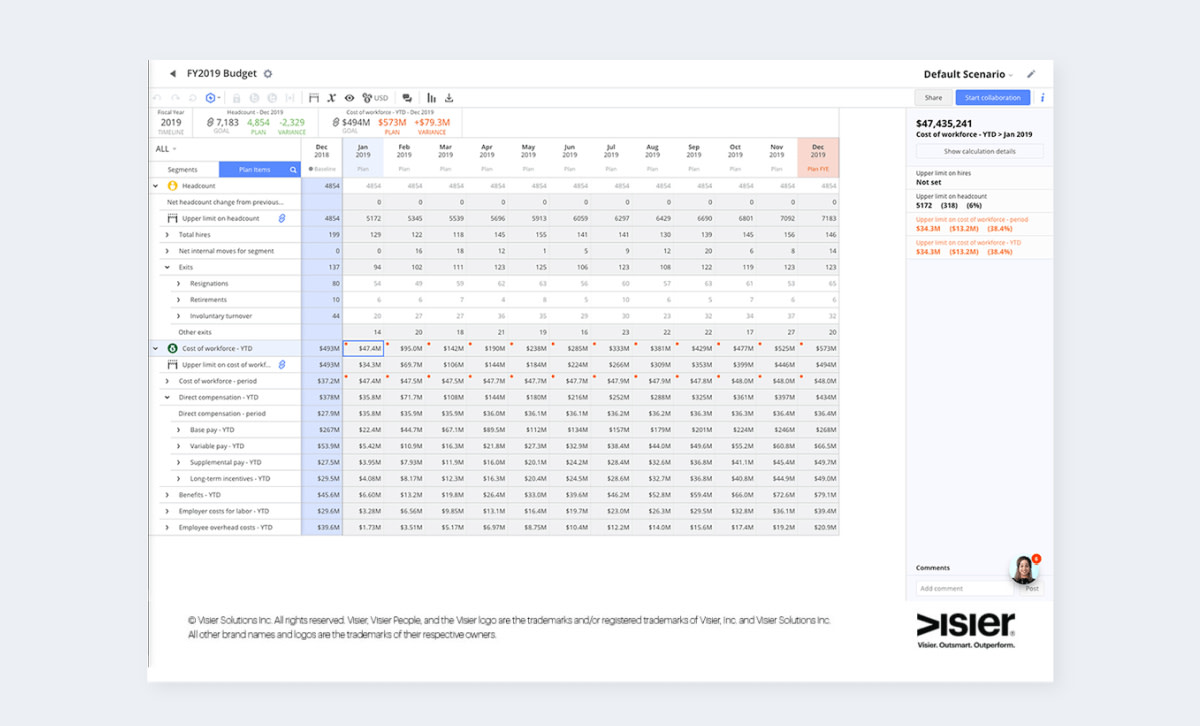The 5 Steps of Analytics-Driven Workforce Planning
Businesses need to make sure they have the right people in the right roles. Use these steps to analytics workforce planning to help.

Businesses need to make sure they have the right people in the right jobs at the right time. This means HR leaders are required to:
Hire people who align with the company’s culture (the right people)
Utilize each employee’s individual skill sets to their highest potential (the right job)
Maintain a sufficient level of staffing in order to deliver on their business model (the right time)
To determine how to align and sustain these three objectives, HR uses some form of workforce planning. Unfortunately, many companies still base their talent plans on unreliable sources and methods such as using country retirement age instead of actual retirement age data, outdated benchmarks, and financial headcount budgets with no historical trends or link to business strategy, and sadly, gut feel.
Weak workforce planning practices lead to an incomplete or inaccurate view of your workforce, as well as a disconnect between data sources, and often excludes historical and future trending data–making it impossible to reliably forecast future changes.
Instead, HR and workforce planners should be looking to people analytics to enable them to make better strategic decisions. Case in point: a professional services organization combined their workforce analytics and workforce planning within a single, integrated solution. With this approach, they were able to staff the optimal mix of junior and senior people, resulting in expected savings of $1 to $3 million per contract.
Here are five key steps to use analytics to inform your workforce plans:
1. Start with the business
HR teams need to incorporate the changing behaviors within their organization into workforce planning, and respond proactively. To do this, don’t start by simply looking at the data otherwise you’ll be hard pressed to find actionable answers in all the rows of numbers and figures.
Instead, start with the business: What are your organizational goals? What issues have been preventing those outcomes from being realized? Use analytics to find the areas where adapting your workforce plan will have the most bottom line impact. Additionally, create and compare different workforce planning scenarios (each with different workforce movement and cost assumptions) so you can choose the best option for your organization, as well as have contingency plans in place.
Furthermore, data-driven workforce planning must also account for changes in the overall industry on a larger scale. For example:
Do you know how customer demographics are changing?
How are larger-scale cultural changes impacting your workforce?
What’s happening out in the world that’s influencing people’s decisions on the jobs they take, when they take them, how long they work there, and why they decide to stay?
With an awareness of where deviations may be happening in the business, you will optimize workforce planning to best support the organization’s goals.
2. Gather stakeholder requirements by asking the right questions
It’s critical to gather input from all your stakeholders, across the entire organization, in order to prevent information gaps. Asking the right questions about your talent pools will surface insights that will truly impact the business.
Modern people analytics platforms also enable HRBPs to help with information-gathering: armed with analytics technology that doesn’t require a data science degree to operate, they can have smarter conversations around workforce planning and answer any questions they previously couldn’t without direct access to the data.
Once you’ve spoken to everyone involved in the workforce plan, utilize analytics to dig deeper into the data. This helps validate what you’ve already learned and uncover new insights and opportunities across the total employee lifecycle (we’ll talk more about employee lifecycle later), that may not be readily apparent on a spreadsheet filled with metrics.
The data you uncover on the business can both answer critical questions, as well as motivate you to dig deeper.
Rob Major, a member of the workforce planning team at Ascension, was asked by their compensation group to demonstrate what it would look like to increase the market rate for a group of nurses from 80% to 100%. In this video, Major explains that by using analytics to inform their plan:
“I know what the cost is now to get them up to market rate. And then I know how much involuntary turnover it will decrease. To be able to get both sides of the equation with workforce planning now is absolutely awesome.”

Data visualization of a workforce plan
3. Use analytics to support talent management and hiring
One of the biggest opportunities for HR and workforce planners is to leverage analytics that span across the entire employee lifecycle: from the moment you begin interacting with a job candidate, to the time they retire (hopefully after many years with your company!).
This approach surfaces information about employee turnover, tenure, and hiring so you get a holistic understanding through your workforce plans, but also enables you to see it may be time to course-correct in order to mitigate issues before they become bigger or take advantage of upcoming opportunities.
For example, if people are starting to leave the organization, and you’re able to link turnover back to onboarding and training metrics, you can proactively adjust your onboarding process, development programs and engagement efforts. By that same token, HR can build strategies to ensure that there’s always a strong talent bench ready to take on key roles. Now you are better equipped to maintain succession through a solid plan of action.
Even if your organization is hitting it out of the park with regards to your overall business goals, this is only contingent on making sure you’re able to continuously retain and/or hire the right people. Remember: data-driven workforce analytics not only helps you hire the right people, it also arms you with the knowledge needed to make sure they stay.
4. Build contingencies with scenario modeling
The old proverb, “When Man plans, God laughs,” is certainly rooted in truth. Once you actually have your workforce plan in place, what would you do to adjust the plan in the event of a change, and execute any necessary contingencies? Whether there’s a shift in the economy, in corporate culture, or within your potential talent pool, employers need to be able to plan for multiple futures ahead of time.
Scenario modeling makes it possible to create several different talent arrays, each with different supply, cost, and business goal alignments. This means asking how changes will impact the organization’s talent needs, understanding who is going to be affected by each possible scenario, and knowing what the timeframe for the action should be. Having the answers to all these questions ahead of time prepares you to respond and readjust your plan as soon as actual changes start to develop.
If you wait for a possible future to present itself before adjusting your workforce plan, you’re already too late. But if you plan continuously, you can adapt quickly when there’s a significant chance of a specific development occurring.
5. Continuously monitor to plan proactively
There are HR teams that conduct their strategic workforce planning one time each year–it’s often a dreaded calendar date, due to how stressful the traditional process can be. But the key to success lies in your ability to plan several steps ahead of where your organization is currently. This means workforce planning can’t just be a once a year exercise.
Fortunately, agile workforce planning methods enable you to continually regulate the health of your company’s talent pool, so you can stay on top of any changes before they happen.
The key elements of agile workforce planning are:
Continuous activity – the more frequently your workforce plan is revisited, the more accurate and relevant it is.
Awareness – HR teams need to be aware of how the business is doing in relation to key hiring objectives, and support the organization’s goals in response to any deviations.
Collaboration: the HR planning team needs to receive critical input across the entire organization, to ensure there are no knowledge gaps.
Flexibility – the fickle and constantly changing nature of the business world means that HR teams need to be able to adjust their workforce plans quickly.
Strategic workforce planning should never be a one-and-done event. It needs to be constantly iterated upon. When you use a solution that puts all your sources of data in one place, it becomes possible to work with it more frequently (instead of spending time wrestling with data extraction from your various transactional systems), and allows a proactive focus rather than reactive.
Workforce planning is about empowering better decisions
It may seem easier and more natural to simply allow the rhythms of your organization to inform your talent pool–with the idea that eventually, people will either leave on their own or the organization will outgrow the current talent pool based on a shift in business needs. This is all good if talent is always readily available.
But this is a passive way to manage your talent and inevitably leads to a misalignment between your business strategy, workforce planning, and talent acquisition.
Data-driven workforce planning is a critical business process that doesn’t require a huge overhaul in new technologies to get started. The key is to find the right solution that does both analysis and workforce planning: gathering your internal data and external benchmarks as the basis for answering questions, which then empowers you to use that data to make more strategic decisions around talent.
Your people are your organization’s most valuable asset; it’s critical that you use the performance management data, financial data, demographics, employee movement, and training history available to you to inform your workforce planning models. The more you can feed the data from all your sources into one central place, the better prepared you’ll be to have one unified view of your organization–and the more ready you’ll be to make decisions around who to hire, when to hire and how to keep them.
Get the Outsmart newsletter
You can unsubscribe at any time. For more information, check out Visier's Privacy Statement.


